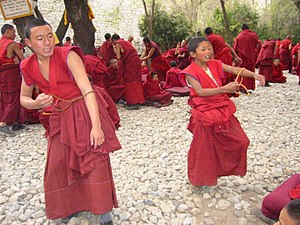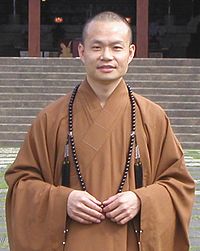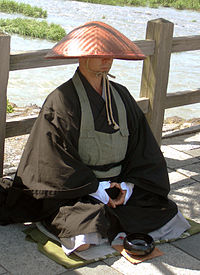Monasticism, also referred to as monachism, or monkhood, is a religious way of life in which one renounces worldly pursuits to devote oneself fully to spiritual work. Monastic life plays an important role in many Christian churches, especially in the Catholic, Orthodox and Anglican traditions as well as in other faiths such as Buddhism, Hinduism and Jainism. In other religions, monasticism is criticized and not practiced, as in Islam and Zoroastrianism, or plays a marginal role, as in modern Judaism. Many monastics live in abbeys, convents, monasteries or priories to separate themselves from the secular world, unless they are in mendicant or missionary orders.

Sangha is a Sanskrit word used in many Indian languages, including Pali which means "association", "assembly", "company" or "community"; In these languages, sangha is frequently used as a surname. In a political context, it was historically used to denote a governing assembly in a republic or a kingdom, and for a long time, it has been used by religious associations, including Buddhists, Jains and Sikhs. Given this history, some Buddhists have stated that the tradition of the sangha represents humanity's oldest surviving democratic institution.
Theravāda is the most commonly accepted name of Buddhism's oldest existing school. The school's adherents, termed Theravādins, have preserved their version of Gautama Buddha's teaching or Buddha Dhamma in the Pāli Canon for over two millennia.
The Vinaya is the division of the Buddhist canon (Tripitaka) containing the rules and procedures that govern the Buddhist Sangha. Three parallel Vinaya traditions remain in use by modern sanghas: the Theravada, Mulasarvastivada and Dharmaguptaka. In addition to these Vinaya traditions, Vinaya texts of several extinct schools of Indian Buddhism are preserved in the Tibetan and East Asian canons, including those of the Kāśyapīya, the Mahāsāṃghika, the Mahīśāsaka, and the Sarvāstivāda

A bhikkhu is an ordained male in Buddhist monasticism. Male and female monastics are members of the Sangha.
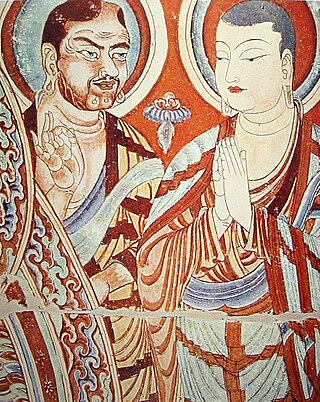
The Dharmaguptaka are one of the eighteen or twenty early Buddhist schools, depending on the source. They are said to have originated from another sect, the Mahīśāsakas. The Dharmaguptakas had a prominent role in early Central Asian and Chinese Buddhism, and their Prātimokṣa are still in effect in East Asian countries to this day, including China, Vietnam, Korea, and Japan as well as the Philippines. They are one of three surviving Vinaya lineages, along with that of the Theravāda and the Mūlasarvāstivāda.

Phra VisuddhisamvaratheraAM, known as Ajahn Brahmavaṃso, or simply Ajahn Brahm, is a British-born Theravada Buddhist monk. Currently, Ajahn Brahm is the abbot of Bodhinyana Monastery in Serpentine, Western Australia; Spiritual Adviser to the Buddhist Society of Victoria; Spiritual Adviser to the Buddhist Society of South Australia; Spiritual Patron of the Buddhist Fellowship in Singapore; Patron of the Brahm Centre in Singapore; Spiritual Adviser to the Anukampa Bhikkhuni Project in the UK; and Spiritual Director of the Buddhist Society of Western Australia (BSWA). He returned to the office on 22 April 2018 after briefly resigning in March, following a contentious vote by members of the BSWA during their annual general meeting.

Upasampadā (Pali) literally denotes "approaching or nearing the ascetic tradition." In more common parlance it specifically refers to the rite and ritual of ascetic vetting (ordination) by which a candidate, if deemed acceptable, enters the community as upasampadān (ordained) and is authorised to undertake ascetic life.

Maechi or Mae chee are Buddhist monastics in Thailand who have dedicated their life to religion, vowing celibacy, living an ascetic life and taking the Eight or Ten Precepts. They occupy a position similar to sāmaṇerī.
The Pratimokṣa is a list of rules governing the behaviour of Buddhist monastics. Prati means "towards" and mokṣa means "liberation" from cyclic existence (saṃsāra).

A sāmaṇera (Pali), Sanskrit: श्रामणेर, is a novice male monastic in a Buddhist context. A female novice is a śrāmaṇerī or śrāmaṇerikā.

Ajahn Candasiri is one of the Theravāda Buddhist monastics who co-founded Chithurst Buddhist Monastery in West Sussex, England, a branch monastery of the Ajahn Chah lineage. She is currently ordained as a ten-precept sīladhārā, the highest level that is allowed for women in the Thai Forest Tradition. She is one of the senior monastics in western Theravāda Buddhism and trained alongside women who later became fully ordained bhikkhunis and abbesses of monasteries.
The International Congress on Buddhist Women's Role in the Sangha: Bhikshuni Vinaya and Ordination Lineages was an historic event that took place July 18–20, 2007. It was a meeting of internationally recognized Buddhist scholars specializing in monastic discipline and history, as well as practitioners. It was expected to be the final discussion of a decades-long dialogue about re-establishing full bhikshuni ordination in Buddhist traditions. Papers and research based on Buddhist texts and contemporary practice traditions in China, Korea, Taiwan, Tibet, and South Asia were presented, between them the Abstract: The Eight Garudhammas. The fourteenth Dalai Lama attended the final day of the conference and conclusions. His letter of support is available to the public.
The Sīladharā Order is a Theravada Buddhist female monastic order established by Ajahn Sumedho at Chithurst Buddhist Monastery, England. Its members are known as Sīladharās.

In Buddhism, an anagārika is a person who has given up most or all of their worldly possessions and responsibilities to commit full-time to Buddhist practice. It is a midway status between a bhikkhu or bhikkhuni and laypersons. An anagārika takes the Eight Precepts, and might remain in this state for life.
The Eight Garudhammas are additional precepts required of bhikkhunis above and beyond the monastic rule (vinaya) that applied to monks. Garu literally means "heavy" and when applied to vinaya, it means "heavy offense that entails penance (mānatta) consisting of 2 weeks" as described in garudhamma rule No. 5. The authenticity of these rules is contested; they were supposedly added to the (bhikkhunis) Vinaya "to allow more acceptance" of a monastic Order for women, during the Buddha's time. They are controversial because they attempt to push women into an inferior role and because many Buddhists, especially Bhikkhunis, have found evidence that the eight Garudhammas are not really the teachings of Gautama Buddha.
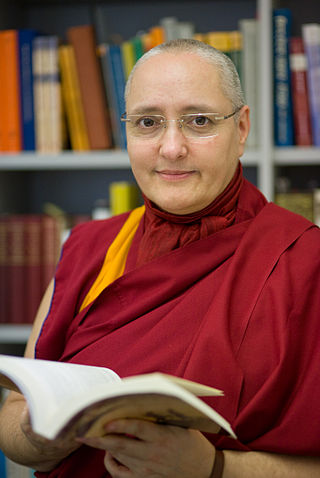
Carola Roloff is a German Buddhist nun. Her monastic name is Bhiksuni Jampa Tsedroen. An active teacher, translator, author, and speaker, she is instrumental in campaigning for equal rights for Buddhist nuns.
A bhikkhunī or bhikṣuṇī is a fully ordained female in Buddhist monasticism. Male monastics are called bhikkhus. Both bhikkhunis and bhikkhus live by the Vinaya, a set of rules. Until recently, the lineages of female monastics only remained in Mahayana Buddhism and thus were prevalent in countries such as China, Korea, Taiwan, and Vietnam, but a few women have taken the full monastic vows in the Theravada and Vajrayana schools over the last decade. From conservative perspectives, none of the contemporary bhikkuni ordinations in Thailand or Tibet are valid.
Sri Lankan Forest Monks' Tradition claims a long history. As the oldest Theravada Buddhist country in the world, several forest traditions and lineages had been existed, disappeared and re-emerged circularly in Sri Lanka. The current forest traditions and lineages in Sri Lanka have been influenced by the Burmese and Thai traditions which descend from the ancient Indian and Sri Lankan traditions.

Bhante Sujato, known as Ajahn Sujato or Bhikkhu Sujato, is an Australian Theravada Buddhist monk ordained into the Thai forest lineage of Ajahn Chah.



